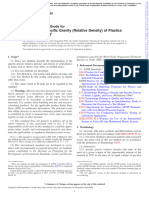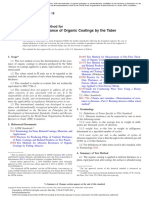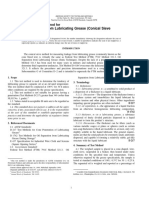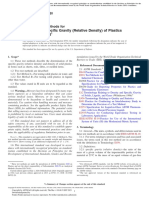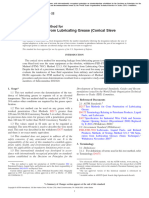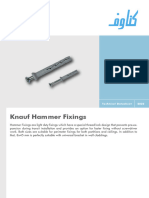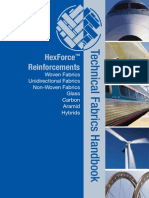Astm D1404M - 99
Astm D1404M - 99
Uploaded by
mancjaCopyright:
Available Formats
Astm D1404M - 99
Astm D1404M - 99
Uploaded by
mancjaOriginal Title
Copyright
Available Formats
Share this document
Did you find this document useful?
Is this content inappropriate?
Copyright:
Available Formats
Astm D1404M - 99
Astm D1404M - 99
Uploaded by
mancjaCopyright:
Available Formats
This international standard was developed in accordance with internationally recognized principles on standardization established in the Decision on Principles
for the
Development of International Standards, Guides and Recommendations issued by the World Trade Organization Technical Barriers to Trade (TBT) Committee.
Designation: D1404/D1404M − 99 (Reapproved 2019)
Standard Test Method for
Estimation of Deleterious Particles in Lubricating Grease1
This standard is issued under the fixed designation D1404/D1404M; the number immediately following the designation indicates the
year of original adoption or, in the case of revision, the year of last revision. A number in parentheses indicates the year of last
reapproval. A superscript epsilon (´) indicates an editorial change since the last revision or reapproval.
1. Scope D4175 Terminology Relating to Petroleum Products, Liquid
1.1 This test method covers a procedure for the detection Fuels, and Lubricants
and estimation of deleterious particles in lubricating grease.
3. Terminology
1.2 This test method is applicable to all lubricating greases.
It can also be used to test other semi-solid or viscous materials. 3.1 Definitions—See Terminology D4175.
Grease fillers, such as graphite and molybdenum disulfide, can 3.2 Definitions:
be tested for abrasive contaminants by first mixing them into 3.2.1 lubricant, n—any material interposed between two
petrolatum or grease known to be free of deleterious particles. surfaces that reduces the friction or wear between them.
1.3 The values stated in either SI units or inch-pound units 3.2.2 lubricating grease, n—a semi-fluid to solid product of
are to be regarded separately as standard. The values stated in a dispersion of a thickener in a liquid lubricant.
each system may not be exact equivalents; therefore, each 3.2.2.1 Discussion—The dispersion of the thickener forms a
system shall be used independently of the other. Combining two-phase system and immobilizes the liquid lubricant by
values from the two systems may result in non-conformance surface tension and other physical forces. Other ingredients are
with the standard. Within the text, the SI units are shown in commonly included to impart special properties.
brackets.
3.2.3 thickener, n—in lubricating grease, a substance com-
1.4 This standard does not purport to address all of the
posed of finely-divided particles dispersed in a liquid lubricant
safety concerns, if any, associated with its use. It is the
to form the product’s structure.
responsibility of the user of this standard to establish appro-
priate safety, health, and environmental practices and deter- 3.2.3.1 Discussion—The solid thickener can be fibers (such
--`,```,`,`,`,`,`,,`,,,`````````-`-`,,`,,`,`,,`---
mine the applicability of regulatory limitations prior to use. as various metallic soaps) or plates or spheres (such as certain
1.5 This international standard was developed in accor- non-soap thickeners), which are insoluble or, at the most, only
dance with internationally recognized principles on standard- very slightly soluble in the liquid lubricant. The general
ization established in the Decision on Principles for the requirements are that the solid particles be extremely small,
Development of International Standards, Guides and Recom- uniformly dispersed, and capable of forming a relatively stable,
mendations issued by the World Trade Organization Technical gel-like structure with the liquid lubricant.
Barriers to Trade (TBT) Committee. 3.3 Definitions of Terms Specific to This Standard:
3.3.1 deleterious particles, n—in lubricating grease, minute
2. Referenced Documents bits of solid material present as a contaminant and abrasive to
2.1 ASTM Standards:2 acrylic plastic.
D235 Specification for Mineral Spirits (Petroleum Spirits)
(Hydrocarbon Dry Cleaning Solvent) 4. Summary of Test Method
D785 Test Method for Rockwell Hardness of Plastics and 4.1 A small portion of the lubricating grease sample is
Electrical Insulating Materials placed between two clean, highly polished acrylic-plastic
plates held rigidly and parallel in metal holders. A pressure of
1
This test method is under the jurisdiction of ASTM Committee D02 on
200 psi [1.38 MPa] is applied, and one plate is rotated 30°
Petroleum Products, Liquid Fuels, and Lubricants and is the direct responsibility of relative to the other. Particles harder than the plastic and
Subcommittee D02.G0.01 on Chemical and General Laboratory Tests. exceeding in size the distance between the plates will imbed in
Current edition approved June 1, 2019. Published July 2019. Originally approved the plates and cause characteristic, arc-shaped scratches in the
in 1956. Last previous edition approved in 2014 as D1404/D1404M – 99 (2014).
DOI: 10.1520/D1404_D1404M-99R19.
plates.
2
For referenced ASTM standards, visit the ASTM website, www.astm.org, or
4.2 The relative number of such solid particles can be
contact ASTM Customer Service at service@astm.org. For Annual Book of ASTM
Standards volume information, refer to the standard’s Document Summary page on estimated by counting the total number of arc-shaped scratches
the ASTM website. on the two plates.
Copyright © ASTM International, 100 Barr Harbor Drive, PO Box C700, West Conshohocken, PA 19428-2959. United States
Copyright ASTM International
Provided by IHS Markit under license with ASTM
1Licensee=Enex Chile S.A./5985366001, User=Ruiz, Francisco
No reproduction or networking permitted without license from IHS Not for Resale, 11/30/2020 17:37:57 MST
D1404/D1404M − 99 (2019)
5. Significance and Use [25.4 mm 6 1.3 mm square by 3.2 mm 6 0.64 mm] uniformly
5.1 The significance of the number of scratches as far as thick, having a Rockwell M hardness of 94 6 10 (Test Method
correlation with field performance is concerned has not been D785), and having highly polished surfaces protected on both
established. A particle which is abrasive to plastic will not sides with protective paper.
necessarily be abrasive to steel or other bearing materials. NOTE 3—Whether dimensioned in inches or millimetres, the plastic test
Some correlation was obtained in that the contaminant used in plates should be fabricated to match the square recesses in holders 2 and
Sample 3 (see 10.1.1) had a greater wear rate in a laboratory 7.
ball bearing abrasive wear test than the contaminant in Sample
2. 7. Reagents and Materials
NOTE 1—The number of scratches obtained cannot be used to draw fine 7.1 Stoddard solvent conforming to Specification D235.
differences between greases, but rather, to group them into two or three (Warning—Flammable. Vapor harmful.)
general classes. One such possible division could be:
NOTE 4—Other naphthas or pure paraffinic hydrocarbons, such as
1 ... . less than 10 scratches
n-heptane, can be substituted providing they are suitably volatile and do
2 ... . 10 to 40 scratches
3 ... . more than 40 scratches not soften or otherwise attack acrylic plastic.
5.2 An advantage of this test method is that each test takes
8. Procedure
only a few minutes to run.
8.1 Use a fine, smoothing file to break sharp edges of one
5.3 This test method is used for quality control and speci-
face of each test plate. (A sharp edge could scratch the face of
fication purpose.
the opposite plate.) Remove plastic filings and dust. Do not
6. Apparatus remove protective paper at this time.
6.1 The test apparatus is shown in Figs. 1 and 2. As 8.2 Completely remove the tension from the spring and
illustrated in Fig. 2, the plastic test plates (commercial acrylic disassemble the apparatus from the top, Fig. 1b. Snap a test
plastic, produced in uniform, highly polished sheets),3,41, are plate into each of the square recesses of holders 2 and 7 (Fig.
rigidly held in a parallel position in square recesses in parts 2 2); locate the plates such that the surfaces with the filed edges
and 7. The holder, 7, is part of the cap assembly, 7 to 11, which are opposite each other.
can be removed as a unit from the body, 3, by removing four NOTE 5—The square recesses should be clean, that is, free of solid
cap screws. The lower plate holder, 2, can slide along the axis material, to preclude uneven loading of the plastic plates.
of the main housing, but it is restricted from turning by keys 8.3 Remove the protective paper from the test plates. The
spaced 180° apart. Pressure is applied to the plastic plates, 13, exposed polished surfaces must be free of scratches and dust.
through the holder, 2, by means of the coil spring, 4, spring Remove any incidental dust with a soft brush (beware of static
follower plate, 5, and loading screw, 6. The large loading screw charges attracting more dust), damp chamois skin, or
also serves as a base for the apparatus. The indicator pin, 12, on compressed-gas (ionizing-type recommended) dust remover.
the spring follower plate, 5, shows the linear amount of spring
compression, which in turn, is a measure of the pressure 8.4 Place a pea-sized (about 0.25 g), representative sample
applied to the two plastic plates. The upper holder, 7, is kept of the test grease on the face of the lower test plate. Bolt on the
from rotating by the threaded pin, 9, which projects through a cap assembly, making sure the threaded pin, 9, is against one
milled slot in cap, 8, and ends with a locking wing nut, 14. To stop. Use the locking wing nut, 14, to retain this position. Turn
the loading screw to apply a pressure of 200 psi [1.38 MPa] as
--`,```,`,`,`,`,`,,`,,,`````````-`-`,,`,,`,`,,`---
rotate the upper plate and holder, the wing nut is loosened, and
the handle, 11, is turned. A leather washer, 10 , between holder, indicated by the pointer and scale and the apparatus maker’s
7, and cap, 8, is used to facilitate turning. spring calibration.
NOTE 2—Although 6.1 describes an apparatus of specific design, any NOTE 6—The scale indicates linear displacement and does not directly
other device that provides the essential operating conditions can be used. indicate pressure. The apparatus should be supplied with a calibration to
Such device is permitted if it can hold the two plastic test plates parallel convert the scale reading to pressure. (Consult the manufacturer if this
to each other; apply and measure a minimum pressure of 200 psi [1.38 calibration information is missing.) One equipment maker reported the
MPa] on the plastic plates; and provide for 30° relative rotation of the two following calibration:
plates.
Scale reading of 29 5 200 psi @ 1.38 mPA# ,65 %. (1)
6.2 Plastic Test Plates4 ,5—acrylic plastic test plates (two Equipment made at other times or by other manufacturers can vary and
per test), 1 in. 6 0.050 in. square by 1⁄8 in. 6 0.025 in. can have different calibrations.
NOTE 7—The pressure applied to the plates determines the thickness of
the grease layer between them. A pressure of 200 psi [1.38 MPa] gave a
3
The sole source of supply of sized test plates known to the committee at this
thinner layer than 100 psi [0.69 MPa], but increasing the pressure from
time is Koehler Instrument Company, Inc., 1595 Sycamore Ave., Bohemia, NY 200 psi to 500 psi [1.38 MPa to 3.45 MPa] caused very little change.
11716. 8.5 With this pressure applied, loosen the locking wing nut,
4
If you are aware of alternative suppliers, please provide this information to
ASTM International Headquarters. Your comments will receive careful consider- 14, on the cap assembly and turn handle, 11, once as far as it
ation at a meeting of the responsible technical committee,1 which you may attend. will go (about 30°).
5
The apparatus shown in Figs. 1 and 2 is available from Falex Corp., 1020
Airpark Dr., Sugar Grove, IL 60554–9585, and from Koehler Instrument Company, 8.6 Release the spring pressure and disassemble the appa-
Inc., 1595 Sycamore Ave., Bohemia, New York 11716. ratus. Carefully remove the plastic plates from their holders.
Copyright ASTM International
Provided by IHS Markit under license with ASTM
2Licensee=Enex Chile S.A./5985366001, User=Ruiz, Francisco
No reproduction or networking permitted without license from IHS Not for Resale, 11/30/2020 17:37:57 MST
D1404/D1404M − 99 (2019)
--`,```,`,`,`,`,`,,`,,,`````````-`-`,,`,,`,`,,`---
(a) Assembled View
(b) Unassembled View
FIG. 1 Apparatus for Determining Deleterious Particles in Lubricating Grease
8.7 Mark the plates for identification and remove the pro- 9. Report
tective paper from the back faces. Wash the test grease from the
9.1 Report the following information:
plates with filtered Stoddard solvent (Warning—Flammable.
Vapor harmful) and blow dry with filtered air. Handle the test 9.1.1 Date,
plates very carefully to avoid accidental scratches. 9.1.2 Grease identity,
8.8 Count and record the total number of arc-shaped 9.1.3 Test pressure to the nearest 10 psi [0.07 MPa], and
scratches on the two plastic test plates. See Fig. 3 for examples 9.1.4 Total number of scratches on the two test plates.
of different degrees of scratching.
Copyright ASTM International
Provided by IHS Markit under license with ASTM
3Licensee=Enex Chile S.A./5985366001, User=Ruiz, Francisco
No reproduction or networking permitted without license from IHS Not for Resale, 11/30/2020 17:37:57 MST
D1404/D1404M − 99 (2019)
1 plastic test plates
2 lower plate holder
3 body FIG. 3 Plastic Test Plates Showing Different Degrees of Scratch-
4 spring ing
5 spring follower plate
6 loading screw
7 upper plate holder
8 cap
9 threaded pin
10 leather washer
10.1.1 A series of cooperative tests were run on three grease
11 handle samples, two of which were artificially contaminated. The
12 indicator pin results from six different laboratories were:
13 key
14 wing nut Sample Average No. Standard
of Scratches Deviation
1 4 6
2 41 8
3 113 27
10.2 Bias—The procedure in Test Method D1404/D1404M
has no bias because the value of the estimation of deleterious
particles in lubricating grease can be defined only in terms of
FIG. 2 Cross-section View of Apparatus a test method.
10. Precision and Bias6 11. Keywords
10.1 Precision—The precision of this test method was not 11.1 abrasive particles; cleanliness; contamination; deleteri-
determined with any currently acceptable guidelines of either
ous particles; lubricating grease; particles; scratch test
ASTM or Committee D02.
6
There is no research report on file because this test method was developed
before research report guidelines were instituted and data are no longer available.
ASTM International takes no position respecting the validity of any patent rights asserted in connection with any item mentioned
in this standard. Users of this standard are expressly advised that determination of the validity of any such patent rights, and the risk
of infringement of such rights, are entirely their own responsibility.
This standard is subject to revision at any time by the responsible technical committee and must be reviewed every five years and
if not revised, either reapproved or withdrawn. Your comments are invited either for revision of this standard or for additional standards
and should be addressed to ASTM International Headquarters. Your comments will receive careful consideration at a meeting of the
responsible technical committee, which you may attend. If you feel that your comments have not received a fair hearing you should
make your views known to the ASTM Committee on Standards, at the address shown below.
This standard is copyrighted by ASTM International, 100 Barr Harbor Drive, PO Box C700, West Conshohocken, PA 19428-2959,
United States. Individual reprints (single or multiple copies) of this standard may be obtained by contacting ASTM at the above
address or at 610-832-9585 (phone), 610-832-9555 (fax), or service@astm.org (e-mail); or through the ASTM website
(www.astm.org). Permission rights to photocopy the standard may also be secured from the Copyright Clearance Center, 222
Rosewood Drive, Danvers, MA 01923, Tel: (978) 646-2600; http://www.copyright.com/
--`,```,`,`,`,`,`,,`,,,`````````-`-`,,`,,`,`,,`---
Copyright ASTM International
Provided by IHS Markit under license with ASTM
4Licensee=Enex Chile S.A./5985366001, User=Ruiz, Francisco
No reproduction or networking permitted without license from IHS Not for Resale, 11/30/2020 17:37:57 MST
You might also like
- ASTM D3359-22 Standard Test Methods For Rating Adhesion by Tape TestDocument8 pagesASTM D3359-22 Standard Test Methods For Rating Adhesion by Tape TestManuela Castañeda100% (4)
- ASTM D2697-22 EnglishDocument4 pagesASTM D2697-22 Englishbdr85No ratings yet
- Astm D792-20Document6 pagesAstm D792-20Александр ЛNo ratings yet
- 5th Floor BuildingDocument15 pages5th Floor Buildingعبدالمجيد اشرف عادل مجيدNo ratings yet
- ASTM D1831 - 19aDocument4 pagesASTM D1831 - 19amancjaNo ratings yet
- D4870 22-5-02 Standard Test Method For Determination of Total SedimentDocument8 pagesD4870 22-5-02 Standard Test Method For Determination of Total SedimentHamidreza AraghianNo ratings yet
- Astm D8120 - 17Document4 pagesAstm D8120 - 17mancja100% (2)
- Astm D8184 - 18Document7 pagesAstm D8184 - 18mancja100% (3)
- D4060.37296 - Taber Abraser TestDocument6 pagesD4060.37296 - Taber Abraser TestJeremy100% (1)
- S355J2 Plate MTCDocument2 pagesS355J2 Plate MTCHarminder Kumar100% (2)
- Astm D8127 - 17Document8 pagesAstm D8127 - 17mancjaNo ratings yet
- Astm D93 - 19Document18 pagesAstm D93 - 19mancja100% (5)
- Mas Register Civil 09-01-2020Document5 pagesMas Register Civil 09-01-2020Kannan MurugesanNo ratings yet
- Estimation of Deleterious Particles in Lubricating Grease: Standard Test Method ForDocument4 pagesEstimation of Deleterious Particles in Lubricating Grease: Standard Test Method ForRayzha NoerfiqriNo ratings yet
- Astm D 566 - 17Document5 pagesAstm D 566 - 17lynndonnNo ratings yet
- D2265-22 (Standard Test Method For Dropping Point of Lubricating Grease Over Wide Temperature Range)Document6 pagesD2265-22 (Standard Test Method For Dropping Point of Lubricating Grease Over Wide Temperature Range)Wensen YapNo ratings yet
- Evaporation Loss of Lubricating Greases Over Wide-Temperature RangeDocument4 pagesEvaporation Loss of Lubricating Greases Over Wide-Temperature RangeErick Santiago CubillosNo ratings yet
- D972-02 (2008) - Standard Test Method For Evaporation Loss of Lubricating Greases and OilsDocument4 pagesD972-02 (2008) - Standard Test Method For Evaporation Loss of Lubricating Greases and OilsJoanneLimNo ratings yet
- Astm D1831 19Document2 pagesAstm D1831 19nazarienNo ratings yet
- ASTM D566-16 Dropping Point of Lubricating GreaseDocument2 pagesASTM D566-16 Dropping Point of Lubricating GreaseHydrocarbonE.C AdminNo ratings yet
- ASTM D4048 - 19aDocument5 pagesASTM D4048 - 19amancjaNo ratings yet
- Foaming Characteristics of Lubricating Oils: Standard Test Method ForDocument11 pagesFoaming Characteristics of Lubricating Oils: Standard Test Method ForGabriela EhlertNo ratings yet
- Evaporation Loss of Lubricating Greases and Oils: Standard Test Method ForDocument5 pagesEvaporation Loss of Lubricating Greases and Oils: Standard Test Method ForRonnyNo ratings yet
- ASTM D6079.dvfr3720 PDFDocument8 pagesASTM D6079.dvfr3720 PDFangel100% (2)
- Astm D3359-22Document8 pagesAstm D3359-22massimiliano.melisNo ratings yet
- Astm D5402 (2019)Document2 pagesAstm D5402 (2019)uziNo ratings yet
- Astm D892 - 10Document10 pagesAstm D892 - 10Kamruzaman MiahNo ratings yet
- Metalworking Fluids and Related Materials: Standard Classification ForDocument3 pagesMetalworking Fluids and Related Materials: Standard Classification ForteaNo ratings yet
- Misting Properties of Lubricating Fluids: Standard Test Method ForDocument7 pagesMisting Properties of Lubricating Fluids: Standard Test Method ForBlack MambaNo ratings yet
- Foaming Characteristics of Lubricating Oils: Standard Test Method ForDocument11 pagesFoaming Characteristics of Lubricating Oils: Standard Test Method ForTarlan AllahverdiyevNo ratings yet
- Evaluating Lubricity of Diesel Fuels by The High-Frequency Reciprocating Rig (HFRR) by Visual ObservationDocument9 pagesEvaluating Lubricity of Diesel Fuels by The High-Frequency Reciprocating Rig (HFRR) by Visual ObservationTsogtsaihan MyahlaiNo ratings yet
- Astm D892 2018Document10 pagesAstm D892 2018GansehNo ratings yet
- Astm D 6079Document8 pagesAstm D 6079Jesús GarcíaNo ratings yet
- Astm D 6184Document3 pagesAstm D 6184김인식No ratings yet
- Dilute Solution Viscosity of Ethylene Polymers: Standard Test Method ForDocument6 pagesDilute Solution Viscosity of Ethylene Polymers: Standard Test Method Forvinit kumarNo ratings yet
- Standard Classification of Industrial Fluid Lubricants by Viscosity SystemDocument2 pagesStandard Classification of Industrial Fluid Lubricants by Viscosity SystemGhania Nashwa FairuzaNo ratings yet
- D1743-22 (Standard Test Method For Determining Corrosion Preventive Properties of Lubricating Greases)Document12 pagesD1743-22 (Standard Test Method For Determining Corrosion Preventive Properties of Lubricating Greases)Wensen YapNo ratings yet
- Astm D 566Document5 pagesAstm D 566casilvaNo ratings yet
- Lubrication and Hydraulic Filter Debris Analysis (FDA) For Condition Monitoring of MachineryDocument21 pagesLubrication and Hydraulic Filter Debris Analysis (FDA) For Condition Monitoring of MachineryasmaNo ratings yet
- Cone Penetration of Lubricating Grease Using One-Quarter and One-Half Scale Cone EquipmentDocument8 pagesCone Penetration of Lubricating Grease Using One-Quarter and One-Half Scale Cone EquipmentAhmedNo ratings yet
- Astm D972Document4 pagesAstm D972rhsousaNo ratings yet
- Astm D5001-23Document12 pagesAstm D5001-23an NanNo ratings yet
- ASTM G181 21 Piston RingsDocument7 pagesASTM G181 21 Piston RingsSam HippeNo ratings yet
- D4060-14 Standard Test Method For Abrasion Resistance of Organic Coatings by The Taber AbraserDocument5 pagesD4060-14 Standard Test Method For Abrasion Resistance of Organic Coatings by The Taber AbraserMaria Fernanda Carrasco IdrovoNo ratings yet
- Astm D445-21Document18 pagesAstm D445-21Clinton SiregarNo ratings yet
- D 7918 - 15Document9 pagesD 7918 - 15asmaNo ratings yet
- Astmd968 22Document6 pagesAstmd968 22Tatiana ViannaNo ratings yet
- Epoxy Resins: Standard Specification ForDocument3 pagesEpoxy Resins: Standard Specification Fornicolas fernando cardona valenciaNo ratings yet
- Standard Test Methods For Cone Penetration of Lubricating GreaseDocument14 pagesStandard Test Methods For Cone Penetration of Lubricating GreaseVedang Bhagwat100% (1)
- ASTM D 4176 - Standard Test Method For Free Water and Particulate Contamination in Distillate Fuels (Visual Inspection Procedures)Document4 pagesASTM D 4176 - Standard Test Method For Free Water and Particulate Contamination in Distillate Fuels (Visual Inspection Procedures)carolccamposNo ratings yet
- Density and Specific Gravity (Relative Density) of Plastics by DisplacementDocument6 pagesDensity and Specific Gravity (Relative Density) of Plastics by DisplacementGabriel Herrera GonzalezNo ratings yet
- Industrial Fluid Lubricants by Viscosity System: Standard Classification ofDocument2 pagesIndustrial Fluid Lubricants by Viscosity System: Standard Classification ofTarlan AllahverdiyevNo ratings yet
- Astm D1200Document2 pagesAstm D1200DIEGO ALBUQUERQUENo ratings yet
- Determination of Corrosion - Preventive Properties of Lubricating Greases Under Dynamic Wet Conditions (Emcor Test)Document5 pagesDetermination of Corrosion - Preventive Properties of Lubricating Greases Under Dynamic Wet Conditions (Emcor Test)julianNo ratings yet
- Astm D-1403Document8 pagesAstm D-1403김인식No ratings yet
- ASTM C 542-05 - Standard Specification For Lock-Strip GasketsDocument5 pagesASTM C 542-05 - Standard Specification For Lock-Strip GasketsDJ JMNo ratings yet
- Polyvinyl Acetate-Based Emulsion Adhesives: Standard Specification ForDocument6 pagesPolyvinyl Acetate-Based Emulsion Adhesives: Standard Specification Forgokhanekinci92No ratings yet
- Evaluation of Load-Carrying Capacity of Lubricants Used in Hypoid Final-Drive Axles Operated Under Low-Speed and High-Torque ConditionsDocument18 pagesEvaluation of Load-Carrying Capacity of Lubricants Used in Hypoid Final-Drive Axles Operated Under Low-Speed and High-Torque Conditionsomar TahaNo ratings yet
- ASTM C 1115-17 - Standard Specification For Dense Elastomeric Silicone Rubber Gaskets and AccessoriesDocument5 pagesASTM C 1115-17 - Standard Specification For Dense Elastomeric Silicone Rubber Gaskets and AccessoriesDJ JMNo ratings yet
- Fuel Oils: Standard Specification ForDocument13 pagesFuel Oils: Standard Specification ForyasirNo ratings yet
- Film Hardness by Pencil Test: Standard Test Method ForDocument3 pagesFilm Hardness by Pencil Test: Standard Test Method ForNameNo ratings yet
- Astm D4060 14Document5 pagesAstm D4060 14hadi ebrahimfathNo ratings yet
- D6184-14 Standard Test Method For Oil Separation From Lubricating Grease (Conical Sieve Method)Document4 pagesD6184-14 Standard Test Method For Oil Separation From Lubricating Grease (Conical Sieve Method)Salvatore LombardoNo ratings yet
- D6184 22 5 02 Standard Test Method For Oil Separation From LubricatingDocument4 pagesD6184 22 5 02 Standard Test Method For Oil Separation From LubricatingBetsy WiedenfeldNo ratings yet
- ASTM D1646-19aDocument3 pagesASTM D1646-19aadinathproductionNo ratings yet
- Advanced Level of Dental Resins - Material Science & Technology: 2nd Edtion / 2nd VersionFrom EverandAdvanced Level of Dental Resins - Material Science & Technology: 2nd Edtion / 2nd VersionNo ratings yet
- Machinery Oil Analysis & Condition Monitoring : A Practical Guide to Sampling and Analyzing Oil to Improve Equipment ReliabilityFrom EverandMachinery Oil Analysis & Condition Monitoring : A Practical Guide to Sampling and Analyzing Oil to Improve Equipment ReliabilityRating: 3.5 out of 5 stars3.5/5 (5)
- Astm D4863 - 13Document10 pagesAstm D4863 - 13mancjaNo ratings yet
- Astm D1405 - 08Document7 pagesAstm D1405 - 08mancjaNo ratings yet
- Company Lubricant ISO Base Oil AmsoilDocument39 pagesCompany Lubricant ISO Base Oil AmsoilmancjaNo ratings yet
- Fluidscan Handheld Lubricant Condition MonitorDocument11 pagesFluidscan Handheld Lubricant Condition MonitormancjaNo ratings yet
- Astm D8126 - 17Document7 pagesAstm D8126 - 17mancjaNo ratings yet
- Astm D7962 - 17Document3 pagesAstm D7962 - 17mancjaNo ratings yet
- Astm D4857 - 12Document10 pagesAstm D4857 - 12mancjaNo ratings yet
- Astm D8164 - 19Document5 pagesAstm D8164 - 19mancjaNo ratings yet
- Astm D8278 - 19Document4 pagesAstm D8278 - 19mancjaNo ratings yet
- Astm D8047 - 19Document43 pagesAstm D8047 - 19mancjaNo ratings yet
- Astm D8185 - 18Document19 pagesAstm D8185 - 18mancja100% (1)
- ASTM D287 - 12bDocument5 pagesASTM D287 - 12bmancjaNo ratings yet
- Astm D8305 - 19Document7 pagesAstm D8305 - 19mancjaNo ratings yet
- ASTM D97 - 17bDocument7 pagesASTM D97 - 17bmancjaNo ratings yet
- Astm D156 - 15Document6 pagesAstm D156 - 15mancja100% (2)
- Astm D92 - 18Document11 pagesAstm D92 - 18mancja100% (1)
- Re Civil BOQ Format For Electrical Works - Manfo - BengaluruDocument25 pagesRe Civil BOQ Format For Electrical Works - Manfo - BengaluruDarshit VyasNo ratings yet
- Feeder Canal Lining 29Document12 pagesFeeder Canal Lining 29ABAMELANo ratings yet
- Segmental Concrete Bridges: International Case StudiesDocument4 pagesSegmental Concrete Bridges: International Case StudiesSantosoNo ratings yet
- Knauf Hammer Fixing ScrewDocument2 pagesKnauf Hammer Fixing ScrewAmir SohailNo ratings yet
- BoQ Model For ReservoirDocument41 pagesBoQ Model For ReservoirPo RaksmeyNo ratings yet
- Formwork Is An Ancillary ConstructionDocument25 pagesFormwork Is An Ancillary ConstructionSarinNo ratings yet
- GCPAT Bituthene 3000 and Bituthene Low Temperature Membranes Us 65576Document7 pagesGCPAT Bituthene 3000 and Bituthene Low Temperature Membranes Us 65576sameerace.kolonNo ratings yet
- PWA Contractors Feedback Survey RevDocument26 pagesPWA Contractors Feedback Survey Revmusaed tayyarNo ratings yet
- Proposed Concrete Water TankDocument9 pagesProposed Concrete Water TankAshiraf sserugoNo ratings yet
- A 3D-Printed Honeycomb Cell Geometry Design With Enhanced Energy Absorption Under Axial and Lateral Quasi-Static Compression LoadsDocument17 pagesA 3D-Printed Honeycomb Cell Geometry Design With Enhanced Energy Absorption Under Axial and Lateral Quasi-Static Compression LoadsgandorcNo ratings yet
- Advances in Micro Cutting Tool Design and Fabrication: International Journal of Extreme ManufacturingDocument30 pagesAdvances in Micro Cutting Tool Design and Fabrication: International Journal of Extreme Manufacturingarvind kumarNo ratings yet
- 3Document2 pages3Barış ToprakNo ratings yet
- Effects of Solution Treatment Temperatures On Microstructure and Mechanical Properties of TIG-MIG Hybrid Arc Additive Manufactured 5356 Aluminum AlloyDocument13 pagesEffects of Solution Treatment Temperatures On Microstructure and Mechanical Properties of TIG-MIG Hybrid Arc Additive Manufactured 5356 Aluminum Alloya.h khNo ratings yet
- Construction and Building Materials: Wayne Dodds, Christian Christodoulou, Chris Goodier, Simon Austin, David DunneDocument11 pagesConstruction and Building Materials: Wayne Dodds, Christian Christodoulou, Chris Goodier, Simon Austin, David DunneMohammed BasheerNo ratings yet
- Mani Esti MationDocument49 pagesMani Esti MationAnonymous 3hPIuGABNo ratings yet
- Pt. Wufu Steel Indonesia - Harga Besi Hollow Stainless SteelDocument5 pagesPt. Wufu Steel Indonesia - Harga Besi Hollow Stainless Steelcecep mahmudinNo ratings yet
- Catálogo DonicDocument100 pagesCatálogo DonicAlfonso C.ANo ratings yet
- AS2074 CastSteel Specifications PDFDocument5 pagesAS2074 CastSteel Specifications PDFZac NastNo ratings yet
- S-Weld Passivator GelDocument3 pagesS-Weld Passivator Gelananth rajanNo ratings yet
- SEVS14-004D SumitomoDocument14 pagesSEVS14-004D SumitomoДенис ТимофеевNo ratings yet
- Fabric Handbook March 2009 V 2Document80 pagesFabric Handbook March 2009 V 2chiqui79100% (1)
- Metallography, Microstructure, and Analysis: Covers The Methods of Evaluation of Metallic Materials For Use in TheDocument1 pageMetallography, Microstructure, and Analysis: Covers The Methods of Evaluation of Metallic Materials For Use in TheGerald See TohNo ratings yet
- Why Steel Reinforcement Is Needed in Concrete SlabsDocument2 pagesWhy Steel Reinforcement Is Needed in Concrete SlabsAuYongTheanSengNo ratings yet
- Basf Masterglenium 27 TdsDocument4 pagesBasf Masterglenium 27 TdsJosé Luis CampelloNo ratings yet
- PPR Pipe Insulation GraphDocument10 pagesPPR Pipe Insulation GraphJonNo ratings yet
- HM 2019TableofContents PDFDocument64 pagesHM 2019TableofContents PDFPhuc Nguyen QuangNo ratings yet
- Metco - Thermal Spray Powders (Nickel Chromium Alloy Boron Nitride)Document3 pagesMetco - Thermal Spray Powders (Nickel Chromium Alloy Boron Nitride)Hamed AhadiNo ratings yet


